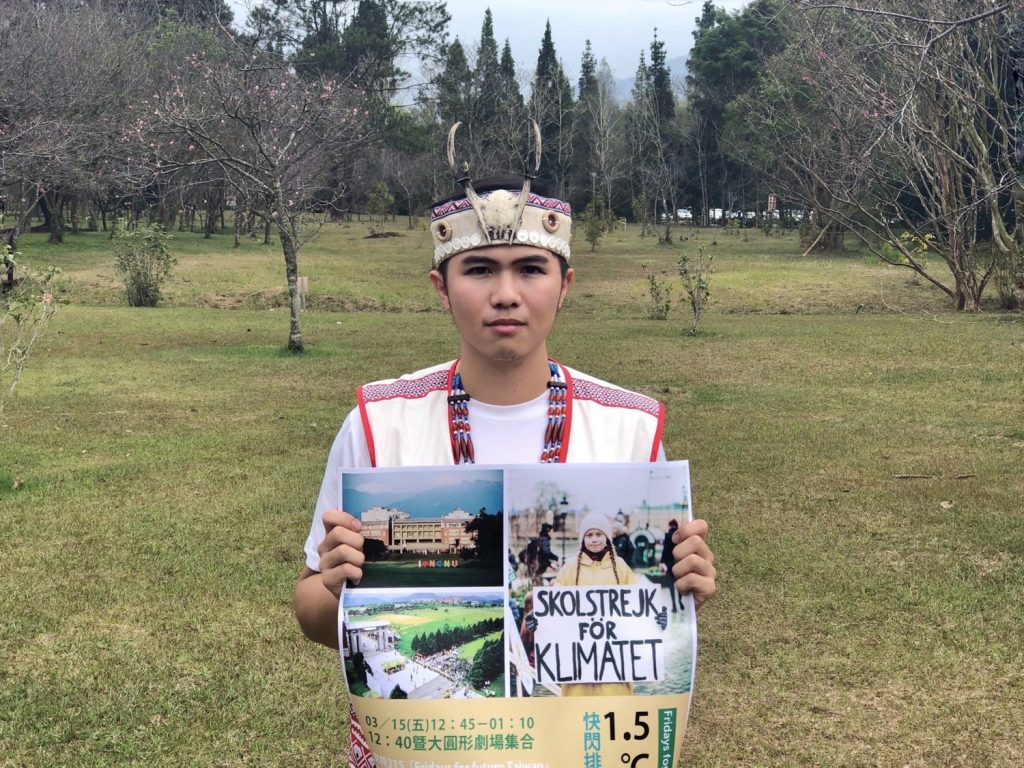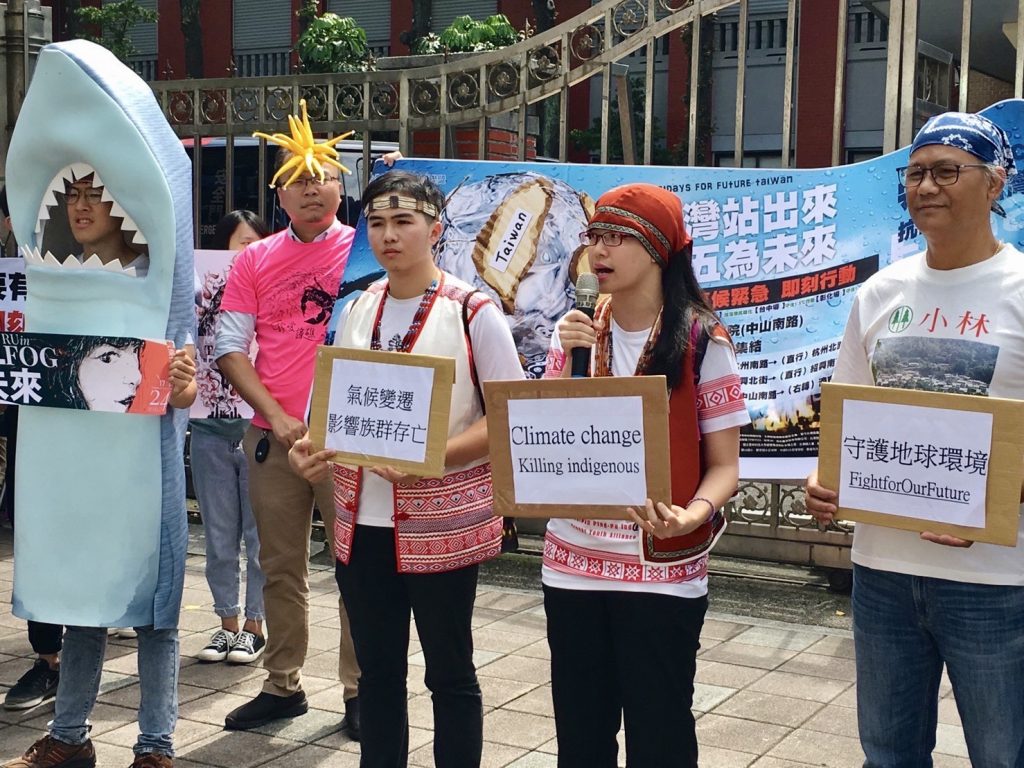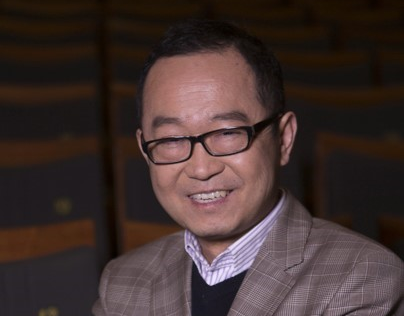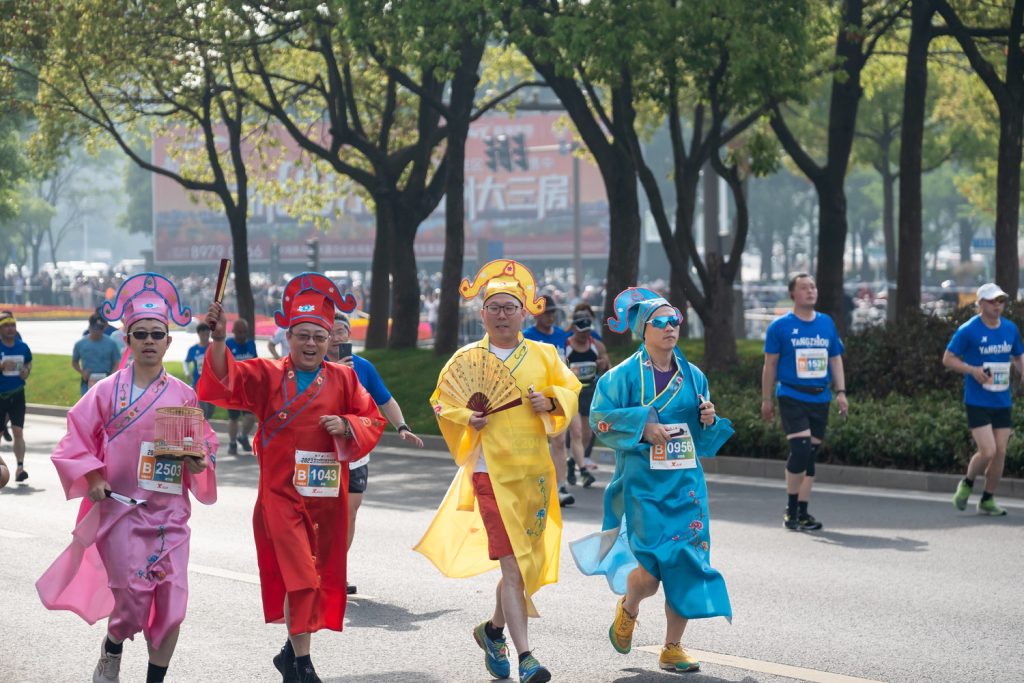When it comes to the history of Taiwan, the focus is usually on the year 1949, when Kuomintang leader Chiang Kai-shek relocated his troops to the island. The centuries-long occupation of Taiwan by various Chinese, European and Japanese forces that preceded it receives less attention – and so does the indigenous population of Taiwan, that felt the increasing influence of each occupier. They were sometimes pushed into mountainous regions, socially marginalized, and their linguistic diversity was thinned out.
Fortunately, this has changed massively in the past decade. Never before in the island’s recent history have the descendants of the indigenous population been as visible as they are now. In sports and pop music, for example, the indigenous minority has produced Taiwan’s biggest stars. Fabian Peltsch spoke with the famous singer Aljenljeng Tjaluvie and climate activist Kaisanan Ahuan. For the pro-democratic government in Taipei, the indigenous minority represents something very special: a Taiwanese identity that has nothing to do with mainland China. However, discrimination remains a problem.
The demand for more China competence in Germany is not new. The CDU/CSU has now made several concrete proposals in its strategy paper on China on how officials in the Federal Republic should learn more about the People’s Republic and its political intentions. Finn Mayer-Kuckuk took a closer look at the paper.


Today, no one calls the indigenous people of Taiwan “wild” or “mountain people” anymore, as they were once derogatorily referred to. On the contrary, never in the island’s recent history have the descendants of the indigenous people been as visible and respected as they are now. In sports and pop music, for example, the indigenous minority has produced Taiwan’s biggest stars – such as Aljenljeng Tjaluvie, also known as ABAO, one of the country’s best-known pop singers. For a few years now, she has been writing the lyrics to her hip-hop and soul-influenced music not in Mandarin but in Paiwan, the language of her ancestors.

“When I first recorded traditional Paiwan songs around 2015, I realized that we are a people without written records,” says Tjaluvie in an interview with Table.Media. “At the same time, we have always recorded our lives in songs and chants.” Her mother and grandmother introduced her to her tribe’s musical tradition at an early age. Now, she says, she wants to inspire young indigenous people for their native languages, some of which are threatened with extinction today.
Taiwan’s indigenous peoples had to endure a lot. Starting in the 16th century, they were fought and oppressed first by Chinese, then by Dutch and finally by Japanese occupiers. Many tribes were driven off their ancestral lands into the mountains. During the Japanese colonial period and the martial law era from 1949 to 1987, their languages were banned. Those who were nevertheless caught using them were punished, beaten and publicly humiliated. According to a Unesco report, at least seven indigenous languages disappeared forever during this period.

Since the beginning of democratization in the 1980s, civil rights groups of the indigenous population in Taiwan were heard for the first time. However, it took until the mid-1990s for Taiwan’s government to specifically promote their concerns with a “Basic Law for Indigenous Peoples”. And it took even longer for a Taiwanese head of state to apologize to the indigenous people: “For 400 years, every regime that has come to Taiwan has brutally violated the rights of indigenous peoples through armed invasion and land seizure,” President Tsai Ing-wen, who herself has indigenous roots, declared in 2016.
“For that, I apologize to the indigenous peoples on behalf of the government.” Today, Taiwan adorns itself with the cultural diversity of the indigenous peoples. Aug. 1 has been their official holiday since 2005. But all of this has to do with more than just philanthropy. By appropriating the indigenous peoples, Taiwan’s democratic government also refers to a Taiwanese identity that has nothing to do with mainland China.
Indigenous people have lived on the island for at least 5,000 years. Due to linguistic similarities, ethnologists assume that they go back to Austronesian ethnic groups from the Pacific islands, who migrated in several waves. Today, their descendants make up about two percent of Taiwan’s 23.5 million people. Officially, 16 tribes are recognized by the government.
Most of them live in the rural coastal regions around Hualian and Taitung in the east of the island. Tjaluvie’s family also comes from here. “Many people still don’t understand what everyday life is like for an ethnic minority,” she sums up. Since her parents were young, however, a lot has changed socially. “Young people, in particular, are now using social media to show indigenous culture in the present, rather than just reproducing stereotypes.”

One of these young people is Kaisanan Ahuan. The 30-year-old activist campaigns for the rights of indigenous peoples but also for climate action issues. Ahuan belongs to the minority Taokas, a tribe with between 2,000 and 3,000 members that has not yet been recognized by the government and therefore receives hardly any state support.
Even though Taiwan’s society is more open today, discrimination and disadvantages remain a problem, Ahuan says in an interview with Table.Media. Indigenous minorities remain among the poorest residents on the island. Their household income is 40 percent below the national average. Issues of land use, hunting rights, pensions and self-government remain problem areas and topics of dispute with the government.
“The majority of the Han population has a certain image of us. That we drink too much and are lazy,” he explains. Time and again, conflicts arise, he says. Some Taiwanese consider the indigenous people to be overrepresented, for example, through admission quotas at universities. “When I was studying at the university in Taipei, the others made jokes. They asked, ‘Did you ride here on a wild boar?’ I didn’t think it was funny.”
Another problem that particularly affects indigenous people is climate change, Ahuan says. “When nature changes, we notice it earlier than people in the city.” Last year, for example, heavy rains in southern Taiwan flooded several indigenous villages. Three were completely cut off from the outside world, leaving 400 people without food and water. “Natural disasters like floods and droughts are happening more and more. We need to be better prepared for such things in the future.”
In 2021 and 2022, he helped organize “Fridays for Future” protests in central Taiwan and Taipei. With his “Central Taiwan Ping-pu Indigenous groups Youth Alliance,” he wants to preserve indigenous languages but also prepare Taiwanese for the consequences of climate change. “We believe that as indigenous people, we have a good knowledge of nature, so we want to show how we can survive natural disasters in the future, for example, by teaching which plants in the mountains are edible and which of them have medicinal effects.” After studying electrical engineering, Ahuan himself moved from Taipei back to his village of Waraoral, near the city of Puli, to learn traditional farming techniques. “We should be taught these things in school,” he thinks.

The CDU/CSU parliamentary group is calling for a broad-based strengthening of China competence in Germany. A new strategy paper from the opposition party includes a longer section on this topic. A meaningful partnership with China is only possible if the German side recognizes and evaluates the risks involved, according to the paper.
The Union makes the following demands:
The expansion of China competence in Germany has already been agreed upon in the coalition agreement by the traffic light coalition. However, the demands of the Union parties go far beyond what has been seen in this direction so far.
The CDU is, however, definitely following an international trend. The British government has just doubled its budget for China competence within its own apparatus. They want to hire many more experts with Mandarin skills and network them. This is being done under a specially set up “China Capabilities Programme“. In London, 170 existing civil servants will also soon receive Chinese lessons. 20 of them are to attend advanced courses in Taiwan.
The need for deeper China knowledge has also been recognized in the USA. A parliamentary committee, the US-China Economic and Security Review Commission, is calling for the establishment of significantly more China expertise in the government. The argument here is that only in this way can risks be evaluated adequately.
According to the Union’s proposal, the China Competence Center of the Chancellor’s Office could also advise states, cities and municipalities. It could help to evaluate risks in Chinese investments in companies and public institutions.
The importance of such an institution is demonstrated by a debate about the planned partnership between Kiel and Qingdao. Since a council decision in Kiel to reach out to each other, cautionary voices have been heard. The University of Kiel points out that Qingdao is also the location of the Chinese submarine fleet and that Chinese spies could spy on the German Navy in Kiel. Such aspects are not immediately obvious to some well-meaning city council members who only think of cooperation in sailing and culture.
At least 29 people have died and dozens more have been injured in a fire at a hospital in Beijing. It was the worst fire in the capital in decades. The fire broke out on Tuesday at the Changfeng Hospital in the southwestern district of Fengtai. Among the victims were patients, a nurse, and a medical assistant. In total, around 80 people were injured. Dramatic videos of patients hanging from windows using knotted bedsheets quickly spread on China’s social media platforms.
The deputy chief of the city’s fire department stated that flammable materials may have ignited during renovation work as the cause of the fire. According to Chinese state media, twelve suspected responsible individuals have been arrested, including the hospital director and two construction company employees. Chinese authorities have ordered an immediate safety review of all hospitals in the capital. rtr/fpe
According to a report by the Washington Post, China possesses spy drones that could travel at three times the speed of sound and could be used in a war scenario with Taiwan. The newspaper cites a secret document from the US National Geospatial Intelligence Agency, which is under the US Department of Defense. The document reportedly contains satellite images from Aug. 9, showing two rocket-powered reconnaissance drones of the WZ-8 type at an air force base in eastern China. According to the Washington Post, the US military believes that the images are “almost certainly” of the Chinese military’s first unmanned aircraft unit.
The installation reportedly falls under the military branch responsible for enforcing China’s sovereignty claims over Taiwan, the newspaper reports. The document underlying the report is part of the so-called Discord leaks – US secret documents that appeared on social media in March. The leaks also refer to the state of the Chinese and Taiwanese militaries in other places. Last week, the Washington Post reported on Taiwan’s inadequate air defense in this regard. rtr
China is falling behind its own commitments in climate financing for the Global South. A new analysis by the think tank E3G shows:
According to the E3G analysis, about two-thirds of China’s international climate financing goes to the area of mitigation, such as the construction of solar and wind power plants or climate-friendly transportation.
There is a strong regional focus in climate financing:
73 percent of the funds came from Chinese development banks such as the China Development Bank and the Export-Import Bank of China. Loans and export credits dominated. The rest is distributed among commercial banks or ministries as well as unspecified sources.
So far, China has refused to participate in planned international climate financing initiatives such as a Loss and Damage Fund. As the People’s Republic officially still qualifies as a “developing country” (Annex II-Country) in the context of the UN Framework Convention on Climate Change, it has fewer obligations for climate financing than Western countries. But this does not have to remain the case.
“As China’s wealth and emissions grow, it will be increasingly difficult to remain in the same group of developing countries, shielded from climate responsibilities, including international climate finance contributions,” said Byford Tsang, Senior Policy Advisor at E3G. nib
In the coming days, China is set to lose the title of the world’s most populous country to India. But it is not just about size, said Foreign Ministry spokesperson Wang Wenbin on Wednesday. “A country’s demographic dividend depends not only on the total number but also on the quality,” he emphasized at a press conference in Beijing. Equally important as the population size is how talented the people are. He also highlighted the importance of education.
There are 900 million people of working age in China who have completed an average of 10.5 years of education, according to Wang. New workers even have 14 years of education, the spokesperson emphasized. In response to the aging of Chinese society, China has taken “active measures”, Wang Wenbin said. “Our population dividend has not disappeared. Our talent dividend is forming and giving strong impetus to development.”
For the first time in more than six decades, China’s population shrank last year. According to the statistics bureau, the People’s Republic had only 1.411 billion inhabitants at the end of 2022, around 850,000 less than a year earlier. ari
Saxony plans to significantly intensify scientific exchange with Taiwan, according to the state’s official website on Tuesday. The plans are the first result of a three-day visit by Saxony’s Minister of Science, Sebastian Gemkow (CDU), to Taipei, where he met with Taiwan’s Minister of Science, Tsung-Tsong Wu, among others.
According to the plan, closer cooperation with the National Applied Research Laboratories, a consortium of high-tech centers for applied research, is planned. Gemkow signed an agreement with the CEO of the National Applied Research Laboratories, Yu-Hsueh Hsu, to further intensify scientific exchange between universities and research institutes in the high-tech regions. Saxony also plans to set up an office in Taipei to coordinate joint activities in this area.
Sebastian Gemkow will be visiting Taiwan until April 20. The minister is accompanied, among others, by the rector of TU Dresden, Ursula M. Staudinger, and representatives of the Fraunhofer Institute for Photonic Microsystems. fpe

After Chinese GDP grew by only 3 percent in 2022, one would have expected the government to set a growth target of at least 6 percent for this year. In fact, virtually no market forecast projects a lower rate. Yet, at last month’s National People’s Congress, outgoing Premier Li Keqiang revealed in his final Government Work Report that the government was aiming for growth of about 5 percent, the lowest target of his tenure.
Under former Premier Wen Jiabao, from 2003 to 2013, China maintained an official growth target of 8 percent. But, in his final Government Work Report, Wen lowered the target for the first time, by 0.5 percentage points. The reason was obvious: Wen wanted to help cool the then-overheated economy. Surprisingly, Wen’s successor, Li, effectively treated 7.5 percent as a ceiling for growth during his ten-year term.
In fact, since 2014, Premier Li has consistently revised China’s growth target a half-point downward from the previous year’s target, whether through a categorical adjustment or the introduction of a lower range. With GDP growth repeatedly falling short of the official target, one cannot help but assume that this was a response to the economy’s actual performance. If existing targets are not being met, why would the government raise them?
Over the past three decades, growth targets have, to some extent, become a self-fulfilling prophecy. From 1993 to 2013, the central government’s growth target was practically interpreted as an indication of what the central government hoped for. That’s why the actual rate of growth was much higher than the government targets. Yes, there were structural forces working in China’s favor during this period. Local governments faced political incentives to implement their growth strategies – including fixed-asset investment and industrial planning – to meet the central government’s priorities and expectations.
Just as rising growth targets encourage local governments to pursue growth more aggressively, falling growth targets can discourage such efforts, leading to lower growth rates that, in turn, spur the government to reduce targets further, causing a downward spiral. All of this makes it difficult to estimate China’s potential rate of growth, which is supposed to be what anchors economic policy. Why did that happen?
China’s slowing GDP growth over the past decade is a reflection not of flawed policy, but of a new policy approach. From 1993 to about 2013, GDP growth was the central government’s primary objective and guided policymakers’ approach to macroeconomic management. This objective – which local governments were tasked with realizing – led to the acceleration of public capital formation, improvements in the investment environment, the crowding in of private capital, and the creation of more productive capacity.
This approach, however, also has its limits, resulting from rapidly increasing marginal costs. While productive investment fuels growth and development, excessive investment leads to diminishing returns and rising debts. The growth-first approach also caused considerable environmental damage, including pollution of China’s air and waters.
The immediate social costs associated with this approach finally pushed China’s government to opt for a new strategy, centered on creating jobs and ensuring macroeconomic stability. On the employment front, China has already achieved considerable success: over the last decade, urban job creation has stood at around 12 million (or more) annually, far exceeding the target – more binding than the GDP target – of 11 million.
China owes these gains largely to rapid progress in high-tech sectors like the platform economy and electric vehicles. New digital technologies have supported rapid growth in the service sector, and bolstered resilience in the labor market more broadly.
If the economy can produce enough jobs, ever-accelerating GDP growth is simply not necessary. Even as GDP growth has plummeted to about half the annual average (10.2 percent) in 2002-12, China has not experienced significant social unrest. Nor has there been a financial crisis or a sharp economic contraction that reverses past progress on living standards, despite the pandemic-induced slump.
China will continue to reap the benefits of its shift from growth-centric policymaking to a focus on jobs. This approach is more conducive to the implementation of structural reforms needed to limit excess investment and reduce debts. It should also spur the adoption of new technologies, generating a virtuous cycle of job creation and productivity growth. Progress in these areas – as well as the convergence of productivity-growth rates across regions – is crucial for the Chinese economy’s medium- to long-term development.
An unfavorable external environment further strengthens the case for China to look beyond growth. The entire global economy is grappling with declining productivity growth and falling demand – trends that will not be reversed any time soon.
Moreover, we are witnessing the collapse of the institutional framework that has underpinned capital-account liberalization worldwide over the last 30 years, as geopolitical tensions lead to an unprecedented surge in cross-border restrictions. More broadly, geopolitics-driven economic policies – not least restrictions imposed on trade with China by the United States – are generating considerable uncertainty in global supply chains and financial markets.
The era of high growth and low inflation is over in the advanced economies and is being succeeded by the “secular stagnation” of which former US Treasury Secretary Lawrence H. Summers has long warned. In this context, emerging-market economies like China are right to abandon the illusion that high growth can be maintained indefinitely. The more likely scenario is a long period – lasting perhaps a decade – of slower growth. China is far better off focusing on employment and working to avoid a systemic financial or debt crisis than attempting to resist the inevitable.
Zhang Jun, Dean of the School of Economics at Fudan University, is Director of the China Center for Economic Studies, a Shanghai-based think tank.
Copyright: Project Syndicate, 2023.
www.project-syndicate.org
Michael Hagemann joined China Grace Trade Limited in Guangzhou as project and sourcing manager at the beginning of the month.
Ruwang Ying has been team leader for the China, Southeast Asia and Middle East departments at KTB Import-Export since March.
Is something changing in your organization? Why not let us know at heads@table.media!

Over the weekend, around 20,000 people participated in the Yangzhou-Jianzhen Half Marathon, including this group of men in historical-looking robes. The name of the half marathon, which has been held annually in Jiangsu province since 2006, also has historical references. It was named after the monk Jianzhen, who worked in Yangzhou in the 8th century before bringing Buddhist teachings to Japan.
When it comes to the history of Taiwan, the focus is usually on the year 1949, when Kuomintang leader Chiang Kai-shek relocated his troops to the island. The centuries-long occupation of Taiwan by various Chinese, European and Japanese forces that preceded it receives less attention – and so does the indigenous population of Taiwan, that felt the increasing influence of each occupier. They were sometimes pushed into mountainous regions, socially marginalized, and their linguistic diversity was thinned out.
Fortunately, this has changed massively in the past decade. Never before in the island’s recent history have the descendants of the indigenous population been as visible as they are now. In sports and pop music, for example, the indigenous minority has produced Taiwan’s biggest stars. Fabian Peltsch spoke with the famous singer Aljenljeng Tjaluvie and climate activist Kaisanan Ahuan. For the pro-democratic government in Taipei, the indigenous minority represents something very special: a Taiwanese identity that has nothing to do with mainland China. However, discrimination remains a problem.
The demand for more China competence in Germany is not new. The CDU/CSU has now made several concrete proposals in its strategy paper on China on how officials in the Federal Republic should learn more about the People’s Republic and its political intentions. Finn Mayer-Kuckuk took a closer look at the paper.


Today, no one calls the indigenous people of Taiwan “wild” or “mountain people” anymore, as they were once derogatorily referred to. On the contrary, never in the island’s recent history have the descendants of the indigenous people been as visible and respected as they are now. In sports and pop music, for example, the indigenous minority has produced Taiwan’s biggest stars – such as Aljenljeng Tjaluvie, also known as ABAO, one of the country’s best-known pop singers. For a few years now, she has been writing the lyrics to her hip-hop and soul-influenced music not in Mandarin but in Paiwan, the language of her ancestors.

“When I first recorded traditional Paiwan songs around 2015, I realized that we are a people without written records,” says Tjaluvie in an interview with Table.Media. “At the same time, we have always recorded our lives in songs and chants.” Her mother and grandmother introduced her to her tribe’s musical tradition at an early age. Now, she says, she wants to inspire young indigenous people for their native languages, some of which are threatened with extinction today.
Taiwan’s indigenous peoples had to endure a lot. Starting in the 16th century, they were fought and oppressed first by Chinese, then by Dutch and finally by Japanese occupiers. Many tribes were driven off their ancestral lands into the mountains. During the Japanese colonial period and the martial law era from 1949 to 1987, their languages were banned. Those who were nevertheless caught using them were punished, beaten and publicly humiliated. According to a Unesco report, at least seven indigenous languages disappeared forever during this period.

Since the beginning of democratization in the 1980s, civil rights groups of the indigenous population in Taiwan were heard for the first time. However, it took until the mid-1990s for Taiwan’s government to specifically promote their concerns with a “Basic Law for Indigenous Peoples”. And it took even longer for a Taiwanese head of state to apologize to the indigenous people: “For 400 years, every regime that has come to Taiwan has brutally violated the rights of indigenous peoples through armed invasion and land seizure,” President Tsai Ing-wen, who herself has indigenous roots, declared in 2016.
“For that, I apologize to the indigenous peoples on behalf of the government.” Today, Taiwan adorns itself with the cultural diversity of the indigenous peoples. Aug. 1 has been their official holiday since 2005. But all of this has to do with more than just philanthropy. By appropriating the indigenous peoples, Taiwan’s democratic government also refers to a Taiwanese identity that has nothing to do with mainland China.
Indigenous people have lived on the island for at least 5,000 years. Due to linguistic similarities, ethnologists assume that they go back to Austronesian ethnic groups from the Pacific islands, who migrated in several waves. Today, their descendants make up about two percent of Taiwan’s 23.5 million people. Officially, 16 tribes are recognized by the government.
Most of them live in the rural coastal regions around Hualian and Taitung in the east of the island. Tjaluvie’s family also comes from here. “Many people still don’t understand what everyday life is like for an ethnic minority,” she sums up. Since her parents were young, however, a lot has changed socially. “Young people, in particular, are now using social media to show indigenous culture in the present, rather than just reproducing stereotypes.”

One of these young people is Kaisanan Ahuan. The 30-year-old activist campaigns for the rights of indigenous peoples but also for climate action issues. Ahuan belongs to the minority Taokas, a tribe with between 2,000 and 3,000 members that has not yet been recognized by the government and therefore receives hardly any state support.
Even though Taiwan’s society is more open today, discrimination and disadvantages remain a problem, Ahuan says in an interview with Table.Media. Indigenous minorities remain among the poorest residents on the island. Their household income is 40 percent below the national average. Issues of land use, hunting rights, pensions and self-government remain problem areas and topics of dispute with the government.
“The majority of the Han population has a certain image of us. That we drink too much and are lazy,” he explains. Time and again, conflicts arise, he says. Some Taiwanese consider the indigenous people to be overrepresented, for example, through admission quotas at universities. “When I was studying at the university in Taipei, the others made jokes. They asked, ‘Did you ride here on a wild boar?’ I didn’t think it was funny.”
Another problem that particularly affects indigenous people is climate change, Ahuan says. “When nature changes, we notice it earlier than people in the city.” Last year, for example, heavy rains in southern Taiwan flooded several indigenous villages. Three were completely cut off from the outside world, leaving 400 people without food and water. “Natural disasters like floods and droughts are happening more and more. We need to be better prepared for such things in the future.”
In 2021 and 2022, he helped organize “Fridays for Future” protests in central Taiwan and Taipei. With his “Central Taiwan Ping-pu Indigenous groups Youth Alliance,” he wants to preserve indigenous languages but also prepare Taiwanese for the consequences of climate change. “We believe that as indigenous people, we have a good knowledge of nature, so we want to show how we can survive natural disasters in the future, for example, by teaching which plants in the mountains are edible and which of them have medicinal effects.” After studying electrical engineering, Ahuan himself moved from Taipei back to his village of Waraoral, near the city of Puli, to learn traditional farming techniques. “We should be taught these things in school,” he thinks.

The CDU/CSU parliamentary group is calling for a broad-based strengthening of China competence in Germany. A new strategy paper from the opposition party includes a longer section on this topic. A meaningful partnership with China is only possible if the German side recognizes and evaluates the risks involved, according to the paper.
The Union makes the following demands:
The expansion of China competence in Germany has already been agreed upon in the coalition agreement by the traffic light coalition. However, the demands of the Union parties go far beyond what has been seen in this direction so far.
The CDU is, however, definitely following an international trend. The British government has just doubled its budget for China competence within its own apparatus. They want to hire many more experts with Mandarin skills and network them. This is being done under a specially set up “China Capabilities Programme“. In London, 170 existing civil servants will also soon receive Chinese lessons. 20 of them are to attend advanced courses in Taiwan.
The need for deeper China knowledge has also been recognized in the USA. A parliamentary committee, the US-China Economic and Security Review Commission, is calling for the establishment of significantly more China expertise in the government. The argument here is that only in this way can risks be evaluated adequately.
According to the Union’s proposal, the China Competence Center of the Chancellor’s Office could also advise states, cities and municipalities. It could help to evaluate risks in Chinese investments in companies and public institutions.
The importance of such an institution is demonstrated by a debate about the planned partnership between Kiel and Qingdao. Since a council decision in Kiel to reach out to each other, cautionary voices have been heard. The University of Kiel points out that Qingdao is also the location of the Chinese submarine fleet and that Chinese spies could spy on the German Navy in Kiel. Such aspects are not immediately obvious to some well-meaning city council members who only think of cooperation in sailing and culture.
At least 29 people have died and dozens more have been injured in a fire at a hospital in Beijing. It was the worst fire in the capital in decades. The fire broke out on Tuesday at the Changfeng Hospital in the southwestern district of Fengtai. Among the victims were patients, a nurse, and a medical assistant. In total, around 80 people were injured. Dramatic videos of patients hanging from windows using knotted bedsheets quickly spread on China’s social media platforms.
The deputy chief of the city’s fire department stated that flammable materials may have ignited during renovation work as the cause of the fire. According to Chinese state media, twelve suspected responsible individuals have been arrested, including the hospital director and two construction company employees. Chinese authorities have ordered an immediate safety review of all hospitals in the capital. rtr/fpe
According to a report by the Washington Post, China possesses spy drones that could travel at three times the speed of sound and could be used in a war scenario with Taiwan. The newspaper cites a secret document from the US National Geospatial Intelligence Agency, which is under the US Department of Defense. The document reportedly contains satellite images from Aug. 9, showing two rocket-powered reconnaissance drones of the WZ-8 type at an air force base in eastern China. According to the Washington Post, the US military believes that the images are “almost certainly” of the Chinese military’s first unmanned aircraft unit.
The installation reportedly falls under the military branch responsible for enforcing China’s sovereignty claims over Taiwan, the newspaper reports. The document underlying the report is part of the so-called Discord leaks – US secret documents that appeared on social media in March. The leaks also refer to the state of the Chinese and Taiwanese militaries in other places. Last week, the Washington Post reported on Taiwan’s inadequate air defense in this regard. rtr
China is falling behind its own commitments in climate financing for the Global South. A new analysis by the think tank E3G shows:
According to the E3G analysis, about two-thirds of China’s international climate financing goes to the area of mitigation, such as the construction of solar and wind power plants or climate-friendly transportation.
There is a strong regional focus in climate financing:
73 percent of the funds came from Chinese development banks such as the China Development Bank and the Export-Import Bank of China. Loans and export credits dominated. The rest is distributed among commercial banks or ministries as well as unspecified sources.
So far, China has refused to participate in planned international climate financing initiatives such as a Loss and Damage Fund. As the People’s Republic officially still qualifies as a “developing country” (Annex II-Country) in the context of the UN Framework Convention on Climate Change, it has fewer obligations for climate financing than Western countries. But this does not have to remain the case.
“As China’s wealth and emissions grow, it will be increasingly difficult to remain in the same group of developing countries, shielded from climate responsibilities, including international climate finance contributions,” said Byford Tsang, Senior Policy Advisor at E3G. nib
In the coming days, China is set to lose the title of the world’s most populous country to India. But it is not just about size, said Foreign Ministry spokesperson Wang Wenbin on Wednesday. “A country’s demographic dividend depends not only on the total number but also on the quality,” he emphasized at a press conference in Beijing. Equally important as the population size is how talented the people are. He also highlighted the importance of education.
There are 900 million people of working age in China who have completed an average of 10.5 years of education, according to Wang. New workers even have 14 years of education, the spokesperson emphasized. In response to the aging of Chinese society, China has taken “active measures”, Wang Wenbin said. “Our population dividend has not disappeared. Our talent dividend is forming and giving strong impetus to development.”
For the first time in more than six decades, China’s population shrank last year. According to the statistics bureau, the People’s Republic had only 1.411 billion inhabitants at the end of 2022, around 850,000 less than a year earlier. ari
Saxony plans to significantly intensify scientific exchange with Taiwan, according to the state’s official website on Tuesday. The plans are the first result of a three-day visit by Saxony’s Minister of Science, Sebastian Gemkow (CDU), to Taipei, where he met with Taiwan’s Minister of Science, Tsung-Tsong Wu, among others.
According to the plan, closer cooperation with the National Applied Research Laboratories, a consortium of high-tech centers for applied research, is planned. Gemkow signed an agreement with the CEO of the National Applied Research Laboratories, Yu-Hsueh Hsu, to further intensify scientific exchange between universities and research institutes in the high-tech regions. Saxony also plans to set up an office in Taipei to coordinate joint activities in this area.
Sebastian Gemkow will be visiting Taiwan until April 20. The minister is accompanied, among others, by the rector of TU Dresden, Ursula M. Staudinger, and representatives of the Fraunhofer Institute for Photonic Microsystems. fpe

After Chinese GDP grew by only 3 percent in 2022, one would have expected the government to set a growth target of at least 6 percent for this year. In fact, virtually no market forecast projects a lower rate. Yet, at last month’s National People’s Congress, outgoing Premier Li Keqiang revealed in his final Government Work Report that the government was aiming for growth of about 5 percent, the lowest target of his tenure.
Under former Premier Wen Jiabao, from 2003 to 2013, China maintained an official growth target of 8 percent. But, in his final Government Work Report, Wen lowered the target for the first time, by 0.5 percentage points. The reason was obvious: Wen wanted to help cool the then-overheated economy. Surprisingly, Wen’s successor, Li, effectively treated 7.5 percent as a ceiling for growth during his ten-year term.
In fact, since 2014, Premier Li has consistently revised China’s growth target a half-point downward from the previous year’s target, whether through a categorical adjustment or the introduction of a lower range. With GDP growth repeatedly falling short of the official target, one cannot help but assume that this was a response to the economy’s actual performance. If existing targets are not being met, why would the government raise them?
Over the past three decades, growth targets have, to some extent, become a self-fulfilling prophecy. From 1993 to 2013, the central government’s growth target was practically interpreted as an indication of what the central government hoped for. That’s why the actual rate of growth was much higher than the government targets. Yes, there were structural forces working in China’s favor during this period. Local governments faced political incentives to implement their growth strategies – including fixed-asset investment and industrial planning – to meet the central government’s priorities and expectations.
Just as rising growth targets encourage local governments to pursue growth more aggressively, falling growth targets can discourage such efforts, leading to lower growth rates that, in turn, spur the government to reduce targets further, causing a downward spiral. All of this makes it difficult to estimate China’s potential rate of growth, which is supposed to be what anchors economic policy. Why did that happen?
China’s slowing GDP growth over the past decade is a reflection not of flawed policy, but of a new policy approach. From 1993 to about 2013, GDP growth was the central government’s primary objective and guided policymakers’ approach to macroeconomic management. This objective – which local governments were tasked with realizing – led to the acceleration of public capital formation, improvements in the investment environment, the crowding in of private capital, and the creation of more productive capacity.
This approach, however, also has its limits, resulting from rapidly increasing marginal costs. While productive investment fuels growth and development, excessive investment leads to diminishing returns and rising debts. The growth-first approach also caused considerable environmental damage, including pollution of China’s air and waters.
The immediate social costs associated with this approach finally pushed China’s government to opt for a new strategy, centered on creating jobs and ensuring macroeconomic stability. On the employment front, China has already achieved considerable success: over the last decade, urban job creation has stood at around 12 million (or more) annually, far exceeding the target – more binding than the GDP target – of 11 million.
China owes these gains largely to rapid progress in high-tech sectors like the platform economy and electric vehicles. New digital technologies have supported rapid growth in the service sector, and bolstered resilience in the labor market more broadly.
If the economy can produce enough jobs, ever-accelerating GDP growth is simply not necessary. Even as GDP growth has plummeted to about half the annual average (10.2 percent) in 2002-12, China has not experienced significant social unrest. Nor has there been a financial crisis or a sharp economic contraction that reverses past progress on living standards, despite the pandemic-induced slump.
China will continue to reap the benefits of its shift from growth-centric policymaking to a focus on jobs. This approach is more conducive to the implementation of structural reforms needed to limit excess investment and reduce debts. It should also spur the adoption of new technologies, generating a virtuous cycle of job creation and productivity growth. Progress in these areas – as well as the convergence of productivity-growth rates across regions – is crucial for the Chinese economy’s medium- to long-term development.
An unfavorable external environment further strengthens the case for China to look beyond growth. The entire global economy is grappling with declining productivity growth and falling demand – trends that will not be reversed any time soon.
Moreover, we are witnessing the collapse of the institutional framework that has underpinned capital-account liberalization worldwide over the last 30 years, as geopolitical tensions lead to an unprecedented surge in cross-border restrictions. More broadly, geopolitics-driven economic policies – not least restrictions imposed on trade with China by the United States – are generating considerable uncertainty in global supply chains and financial markets.
The era of high growth and low inflation is over in the advanced economies and is being succeeded by the “secular stagnation” of which former US Treasury Secretary Lawrence H. Summers has long warned. In this context, emerging-market economies like China are right to abandon the illusion that high growth can be maintained indefinitely. The more likely scenario is a long period – lasting perhaps a decade – of slower growth. China is far better off focusing on employment and working to avoid a systemic financial or debt crisis than attempting to resist the inevitable.
Zhang Jun, Dean of the School of Economics at Fudan University, is Director of the China Center for Economic Studies, a Shanghai-based think tank.
Copyright: Project Syndicate, 2023.
www.project-syndicate.org
Michael Hagemann joined China Grace Trade Limited in Guangzhou as project and sourcing manager at the beginning of the month.
Ruwang Ying has been team leader for the China, Southeast Asia and Middle East departments at KTB Import-Export since March.
Is something changing in your organization? Why not let us know at heads@table.media!

Over the weekend, around 20,000 people participated in the Yangzhou-Jianzhen Half Marathon, including this group of men in historical-looking robes. The name of the half marathon, which has been held annually in Jiangsu province since 2006, also has historical references. It was named after the monk Jianzhen, who worked in Yangzhou in the 8th century before bringing Buddhist teachings to Japan.
